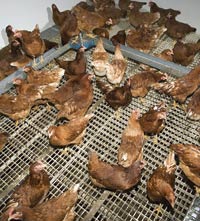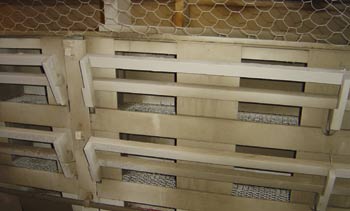Red mite relief with wet powder treatment

Three-and-a-half years ago, Somerset free-range egg producer Jason Thompson was struggling to control red mite in his flock.
“We tried lots of different products, some of which were very expensive,” says Mr Thompson, who runs 21,000 layers on his free-range unit near Sherborne supplying Blackacre Farm Eggs. “But we didn’t find anything that worked and I was fed up of products not working.”
That was until he tried a powder (Hemexsan), based on microscopic one-cell algae. He applied two bags to treat a 6000-bird shed and it worked. There was virtually no red mite and has been using it for the past three years.
His treatment regime consisted of dusting sheds before birds went in and then again as required during the flock cycle
The dust is statically charged as it is applied, which attracts and holds the dust to surfaces. But one limitation is that after 3-4 months, the powder starts to fall off and loses its effectiveness against the mites.
So Mr Thompson decided to investigate a new way of applying the dust as a slurry. “You simply mix the dust with water to create a slurry, and then apply it.

“It seems to penetration the nooks and crannies better than the dust, as it clings to surfaces and runs into the gaps, particularly in the joints in the plastic-slatted flooring. Then it dries out and reverts back to its original state.
“It’s just like putting a coat of paint on to surfaces,” he says.
Another difference is that the slurry approach allows a greater dosing. For example, with 12,000 layers, the dusting system would use four bags of product while the slurry system its 12-14 bags.
So far, Mr Thompson’s first flock under the new system is into its fourth month and the treatment is still working and he believes it will stay for the life of the flock.
During Poultry World’s visit, he pointed out how birds had rubbed it off on the top surface of the nest box, but under the lid where mites live, the coating was still intact. It’s the same with feed tracks, with the product still working underneath.
Dan Wood of Blackacre Farm Eggs has also seen good results with the slurry used in conventional cages. “The first house treated is now 36 weeks into lay and it is still working. “The system is working really well.”
Noble Foods are also showing interest in the system and speaking to Poultry World, Noble Foods technical director Andrew Joret says that using the system has extended the period before producers have had to start treating flocks for red mite. “This means fewer treatments are needed in a flock cycle. This brings several benefits including a saving on treatment costs and reduced use of chemicals.
“We are starting to roll it out on company farms and are still assessing it. We are optimistic about it,” says Mr Joret.
Mr Thompson was so impressed that he started offering a service to other local producers and applying to both cage and free-range units.
“The first thing I ask producers is where have they seen the mites and then I treat the area above in the roof and beams as well as under the floor and feed track. They can’t fly so they have to crawl up walls, so that is the area to treat.”
One aspect that may put off producers using this system is that it may make the building look dirty after just being cleaned. “I can understand why, but it’s better than having walls alive with mites.”
Coupled with this, it just washes off with water at clean out. “The last thing you want is something that lengthens the cleaning process.”
Other control tips
- Removing as many of the internal fittings as practical to ensure good cleaning between flocks
- Red mite occur naturally in the nests and roosts of wild birds so these should be discouraged in the immediate vicinity of the poultry house
- Only source birds from breeder stocks that are certified to be free of red mite
- Take care to ensure transport and staff are not carrying mites following exposure at other sites
